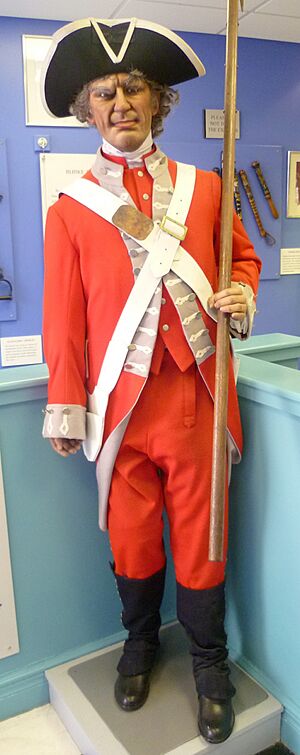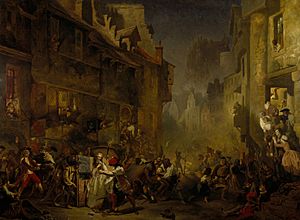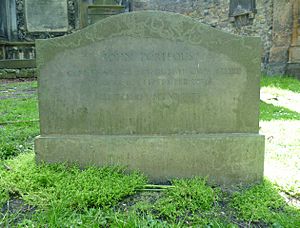John Porteous (soldier) facts for kids
John Porteous (born around 1695 – died 7 September 1736) was a Scottish officer who worked for the Edinburgh City Guard. He became famous because of the Porteous Riots, which led to his death.
Contents
Early Life and Career
John Porteous was born in a place called The Glen, near Traquair, in the Scottish Borders. His father was a tailor, but John didn't want to follow in his footsteps. Instead, he joined the military. He served in the Scots Brigade in the Netherlands.
In 1716, he became a drill master for the Edinburgh City Guard. This was to prepare for a possible uprising by people who supported the old royal family (called Jacobites). Two years later, he became an ensign (a junior officer) in the City Guard. By 1726, he was promoted to captain. It seems Captain Porteous was a bit bossy and not very popular with the ordinary people of Edinburgh.
In 1724, he played a game of golf on Leith Links and lost a bet of 20 guineas to Alexander Elphinstone. Many people watched this game, including important figures like the Duke of Hamilton.
The Riot Begins
On 14 April 1736, three men who were caught smuggling goods – Andrew Wilson, William Hall, and George Robertson – were arrested and sentenced to death. William Hall's sentence was changed to being sent away for life. Wilson and Robertson were waiting for their execution.
A few days before they were to be hanged, Andrew Wilson helped George Robertson escape from his guards. Wilson shouted "Run Geordie, run!" while holding back the officers. George Robertson managed to get away and eventually reached the Netherlands.
Andrew Wilson was the only one left to be publicly hanged in the Grassmarket area of Edinburgh on 14 April 1736. After the hanging, a large crowd became very angry. They started throwing stones at the City Guard.
To try and control the crowd, the Lord Provost of Edinburgh (the city's leader) told Captain Porteous to call out all his guards and make sure they had ammunition.
Shots Fired
As the situation got worse, Captain Porteous ordered his men to fire their guns above the heads of the crowd. However, some people in the tall buildings nearby were accidentally hit and wounded. The crowd grew even more violent. In a moment of panic, Captain Porteous then ordered his guards to shoot directly into the crowd. This terrible decision led to the deaths of six people.
Trial and Delay
Captain Porteous was arrested that same afternoon and charged with murder. His trial took place on 5 July 1736, at the High Court of Justiciary. Many witnesses said they saw Porteous personally shoot into the crowd. However, others said they didn't see him do it.
People in Edinburgh felt very strongly about what had happened. The jury found Captain Porteous guilty of murder. He was sentenced to death and was to be hanged in the Grassmarket on 8 September 1736. Porteous was held in the Tolbooth prison, which was near St Giles' church.
News of these events reached government officials in London. Sir Robert Walpole, a powerful politician, tried to get involved and delay the execution. He didn't realize how angry people in Scotland were. A formal request was made to delay the hanging, and the execution was put off.
Captain Porteous's Death
However, the public was furious about the possible delay in Porteous's execution. People began to plan to kill him themselves. When the authorities heard about this, they decided to increase the guard at the Tolbooth prison. But before they could do this, on the evening of 7 September 1736, a huge crowd of over four thousand people gathered.
The mob marched through the city streets and surrounded the Tolbooth prison. They managed to overpower the guards. Porteous was dragged from his cell and taken towards the Grassmarket. The angry crowd beat him badly. He died a short while later, just before midnight.
Today, a special plaque in the Grassmarket marks the spot where Captain Porteous died. The place where the Tolbooth prison once stood is marked by paving stones shaped like a heart, known as "The Heart of Midlothian." People sometimes spit on this spot, continuing an old tradition to show their dislike for the old prison.
Porteous was buried in Greyfriars Kirkyard in Edinburgh on 9 September. For many years, his grave was marked by a small stone with just the letter 'P' and the date 1736. In 1973, a new headstone was placed there.
What Happened Next
The events in Edinburgh worried the government in London. They were concerned about how to manage Scotland. Some officials, like Queen Caroline, thought Porteous had been unfairly treated. There were even rumors that city leaders were involved in the plot against him.
Some politicians suggested getting rid of the City Guard or removing the Lord Provost from his job. These ideas caused a lot of debate. Scottish politicians and the government disagreed with these proposals, and in the end, nothing was changed.
People had different ideas about who killed Porteous. Some thought it was friends of those who had been shot, or smugglers seeking revenge. Others thought it might be a plot by people who supported the old royal family or religious extremists. However, the way the events were organized suggested careful planning. It is believed that a carpenter named James Maxwell, along with a small group of tradesmen, planned the murder. Even though the government offered a reward of £200 for information, no one was ever brought to justice for Porteous's death.
The story of the Porteous Riots is a big part of the famous novel The Heart of Midlothian by Sir Walter Scott, written in 1818.
Porteous and Golf
Captain John Porteous was one of the early players of the game of golf. In 1724, a golf match between him and Alexander Elphinstone was the first golf game ever reported in a newspaper. Both players were said to be very skilled. Many people came to watch, including the Duke of Hamilton. The bet for the game was twenty guineas, and Elphinstone won the match.
See Also
- Porteous Riots
- Porteous family
- Timeline of golf history 1353–1850





